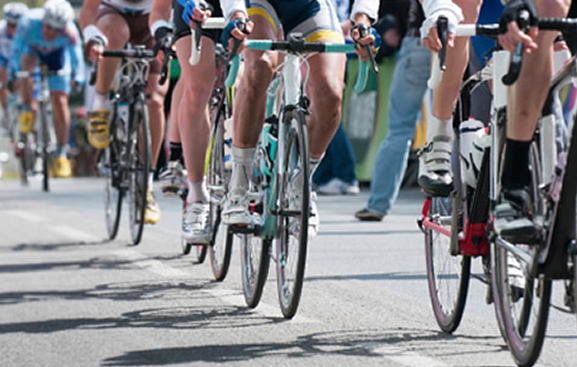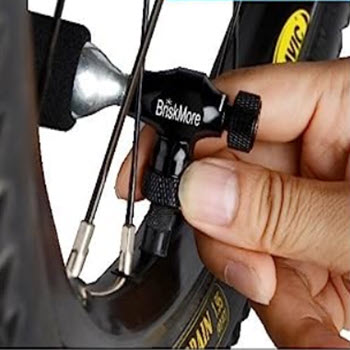Contents
DEVELOPING YOUR BICYCLE BRAIN: THE AFR DRILL
They say it takes a five years or more to become a professional cyclist. It takes this long to develop the cycling physiology and to develop the basics of bike handling and control. We will be showing you a drill to perform to improve your cycling brain and riding skills.
Braking, cornering, and just riding in a pack of riders at 30 mph or faster takes quick reactions and balance. Various cycling drills are necessary not only to ride the bike more efficiently but to ride with more control and confidence.
Being balanced on the bike and creating a sort of symbiotic relationship between your brain and the bike is a way to develop more control and to use appropriate reactions to various unforeseen situations.
YOUR BICYCLE BRAIN MUST EXPECT THE UNEXPECTED
To ride safely, you must always expect the unexpected, especially when riding in a group. Your reactions dictate what happens to you and the riders around you. Your reactions must be quick and accurate but not excessive.
Take a scenario in which your either riding by yourself or with a group. Lets say, you have to make an emergency stop. You can’t always dictate which way your bike will lean or which direction your evasive maneuver will take you.
You want to be able to release from either foot with ease and without having to think about it. The point is, there should be no normal foot to click out of.
If you remember when you first tried the clipless pedals, it was awkward and you might have even fallen once or twice. You eventually felt comfortable and more stable unclipping from your dominate side or leg because it is normally stronger and more coordinated.
One of the reasons you probably fell was because you pulled your ankle slightly upwards instead of keeping the heel down when moving the ankle outward. The more you performed this action the easier it became.
You want to condition the other leg or foot to become just as easy to unclip from for a couple of reasons:
1. to keep balanced on the bike
2. to be able to react quickly, easily and accurately with either leg or foot.
BALANCE IMPORTED TO THE BICYCLE BRAIN
If you unclip from the same side all the time, it becomes subconscious thought, that you must unclip from the dominate or normal side in order to support yourself. This creates an unbalanced state of mind when riding.
INCREASE YOUR REACTION TIME
When you are balanced on the bike and the situation arises where you have to unclip fast there will be no thought process just reaction from the appropriate leg or foot.
 “If what you’re trying to do is difficult or unfamiliar, nearby neurons are drawn into the process to help you out. The brain’s ability to adapt and grow—reorganizing neural pathways and even creating new ones—is called “neuroplasticity.“
“If what you’re trying to do is difficult or unfamiliar, nearby neurons are drawn into the process to help you out. The brain’s ability to adapt and grow—reorganizing neural pathways and even creating new ones—is called “neuroplasticity.“
The drill I came up with and suggest to my riders is the AFR drill, or the Alternating Foot Release drill.
First, in order to feel comfortable before doing this drill on the road, I suggest that they first practice unclipping out of the non-dominate or normal foot. For safety, I would suggest they practice this on a home trainer or a spinning bike at the gym.
DIFFERENT MECHANICS HELP DEVELOP THE BICYCLE BRAIN
Get use to the feeling of the mechanics involved with unclipping with this foot while in the saddle. The un-clipping motion actually involves the whole leg. You want to condition the opposite foot and leg to use the heel down, outward motion. Practice unclipping from the opposite foot while the bike is already stopped and your standing upright.
“To perform these workouts, the brain is forced to strengthen, reorganize and even create new neural pathways. In other words, brain training “rewires” the brain to perform more efficiently than ever before.“
When you become comfortable with un-clipping from the opposite foot, you then can actually start the AFR drill on the road. Every time you come to a stop sign or stop light, alternate the foot you un-clip from. Remember, in the early stages of practicing this start your stop from way out when unclipping.
“by repeating the action many times and sending the corresponding nerve impulses down them many times, you create strong neuro-connections. In contrast, if you repeated the word or action only a few times, then the connections among the new neurons would be weaker, and the new circuit would be harder to reactivate.“
THE DRILL:
Start practicing this drill after a normal training session on the way home. For the first few times, use this procedure:
1. Slow way down
2. Unclip from the opposite foot, and coast for a little bit with the unclipped leg
down and slightly bent.
3. Come to a stop a slow as possible.
4. Just before you stop, lean the bike TOWARD the unclipped side.
5. Turn the wheel AWAY from the unclipped side slightly before you put your foot down.
The more you practice this the more natural it will become. It will eventually feel normal to unclip from either foot. This drill should provide better balance, reaction time, confidence in your bike handling skills, as well as create new neuro-pathways in bicycle brain.
Another advantage of alternating the foot you unclip from is that your pedals and cleats will wear evenly .
Thanks for reading.
Please send comments to info@pacelinebikes.com
We link items through our Amazon Affiliate Links. What are Amazon affiliate links? It’s a way for you to help your favorite creators! And by the way, it doesn’t cost you anything to use our links and we will get a small % of the sale. In fact, you can actually go to another item you were going to buy anyway and tell us thanks by using our link. It’s a win win! We info an our time, you buy what you need. Thank you for your support!




